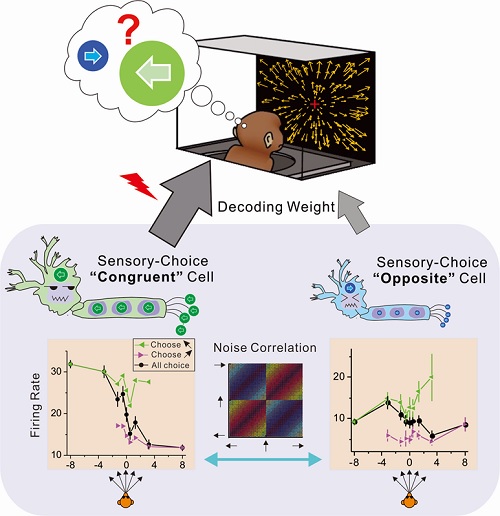Time:2018-09-21
A recent study published in Neuron provides new insights into how neuronal signals in the sensory cortices is decoded, or read out, by downstream areas for decision making. This work was performed by researchers in the laboratory of Spatial Perception at the Institute of Neuroscience, CAS Center for Excellence in Brain Science and Intelligence Technology, CAS Key Laboratory of primate neurobiology, Chinese Academy of Sciences. By electrophysiological recordings from multiple sensory cortices including the Medial Superior Temporal area (MST), the Middle Temporal area (MT) and the Ventral Intraparietal area (VIP) while the monkeys performed an optic-flow motion direction discrimination task, the authors analyzed and dissociated the sensory- and choice-driven components of the neuronal responses. Researchers then applied electrical microstimulation to further examine which component was indeed related to sensory readout.
The generation of perception includes two processes: the encoding process from which sensory inputs activate certain specific sensory neurons in the brain, and the decoding process from which the neuronal activity is further read out by downstream areas for the final perception, decision or motor output. While the encoding process has been addressed heavily, the decoding process is less studied and remains largely unclear. A useful method is to assess the covariation of the neural response and the subjects’ perceptual choice (i.e. choice correlation) on a trial by trial basis to infer sensory readout. For example, stronger firing of the sensory neurons is expected to drive choices more towards their preferred features. However, the reverse could also be true: a top-down signal from the decision may also target the upstream sensory neurons and enhance their activities. Thus, whether the trial-by-trial choice correlation metric can reflect bottom-up sensory readout remains a hot debate. Unfortunately, so far the debate is limited at the theoretical level.
In the current study, graduate student YU Xuefei and Dr. GU Yong trained thesus monkeys to perform an optic-flow motion direction discrimination task. While the animals performed the task, they recorded neuronal responses from three cortical areas MST, MT and VIP. Through partial correlation analysis, they successfully dissociated the sensory- and choice-driven response components and identified two classes of cells, sensory-choice congruent and sensory-choice opposite cells. For sensory-choice congruent cells, the preferred motion direction of the sensory neurons is consistent with the choice-driven signals, for example, both leftward motion and leftward choice enhance the neuron’s response. For sensory-choice opposite cells, the preferred motion direction of the sensory neurons is opposite to the choice-driven signals, for example, leftward optic flow motion selectively enhances the neuron’s response, whereas an opposite rightward choice would also enhance the neuron’s response.
Researchers then applied electrical micro-stimulation on each recording site. They found that micro-stimulation tends to bias the animals’ choice towards the preferred direction of the sensory neurons, instead of the choice-preferred direction. This result demonstrates that, for the first time, sensory signals are read out with respect to their encoded preferred feature (motion direction), whereas unrelated to the choice signals. Interestingly, microstimulation only induces significant effects in MST and MT, but not in VIP, suggesting that the visual motion signals in VIP may not be directly used by the brain for perceptual decision making, at least in the current experimental context. In summary, this work provides important experimental evidence helping to resolve a long existing debate about the potential role of choice correlation observed in sensory cortices.

This work entitled “Probing sensory readout via combined choice correlation measure and micro-stimulation perturbation” was published online in Neuron on September, 20th, 2018. It is completed by graduate students YU Xuefei supervised by Dr. GU Yong, the head of the laboratory of Spatial Perception. This work is supported by grants from the National Natural Science Foundation of China, and the Ministry of China Science and Technology.
 附件下载:
附件下载: